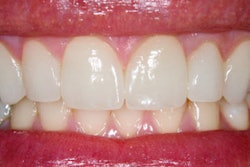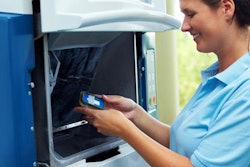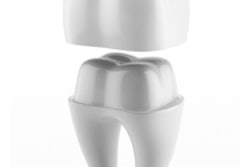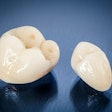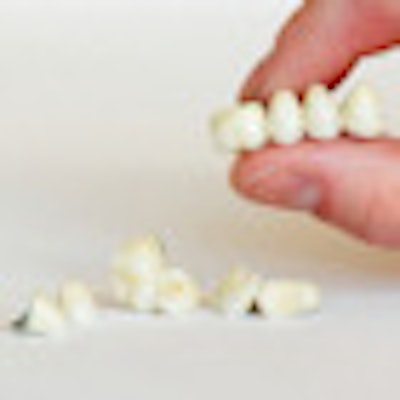
The usage of porcelain restorations among dentists, whether porcelain-fused-to-metal (PFM) or all-ceramic, inevitably leads to cases of chipped restorations. Researchers from the New York University College of Dentistry and the University of Maryland School of Dentistry have completed a study that dentists in such situations may find useful.
In this literature review, the researchers examined how frequently chipping occurs in certain systems and why it happens. The second aspect of the study explored the various means and strategies for repairing chipped porcelain restorations. They also had recommendations for working with different materials.
"Because of differences in the material composition of ceramic systems, different treatments are required for the exposed material surfaces after chipping," the researchers wrote (Journal of the American Dental Association [JADA], January 2013, Vol. 144:1, pp. 31-44). "Use of hydrofluoric acid etching, air abrasion, tribochemical coating, silanization, and metal primers or zirconia primers seem to be the most successful conditioning methods for durable bonding and repair."
While significant long-term data about the life span of all-ceramic restorations has yet to arrive, it appears to be similar to PFM single crowns, and when fractures occur, the veneering porcelain seems to be the most susceptible.
"The results of the majority of studies indicate that chipping of the veneering porcelain is the most frequent complication of zirconia-based restorations," the researchers explained. They also found a wide range of chipping rates, from 0% to 54%, for fixed dental prostheses (FDPs) with zirconia frameworks in at least one and up to three years. But the figures are statistically significantly lower for metal-ceramic FDPs, with one study finding a chipping rate of 3% after five years.
The data for the JADA study was sourced from a PubMed search of scholarly journals using several key words and no language restrictions. The researchers pared down 300 titles to 97 in vitro studies, 21 clinical investigations, and six systematic reviews.
Cracking & chipping
Several different causes of veneering porcelain failure were addressed by these studies. Coefficient of thermal expansion (CTE) is a possibility, which stems from the tensile stresses in the zirconia-porcelain interface where a thermal expansion mismatch could exist. "Researchers generally agree that residual tensile stresses from a CTE mismatch could be highly harmful, affecting both the veneer and the ceramic core material," the authors wrote.
Zirconia's low thermal conductivity was cited as well. Cooling rate disparities between the core material and the veneer can result in high residual stress inside. "The incidence of cracks is expected to increase with greater porcelain veneer thicknesses, especially in combination with fast cooling rates," according to the researchers.
Cracks can also result from phase transition at the porcelain-zirconia interface. While zirconia is incredibly strong, "phase transition leads to tensile stresses on the bottom of the veneering porcelain, probably resulting in starting points for cracks," the authors explained.
They also addressed aging and framework design as potential culprits. In their review, the researchers found studies suggesting that chipping can be reduced with anatomically designed copings and a consistent veneering porcelain thickness. The method of veneering also is a factor, with studies showing "better results for hand-layered veneering porcelain than for veneering porcelain pressed over the frameworks," the researchers stated.
How to fix them
The authors explained that, more often than not, chipping is cosmetic and the restoration can be saved without removing it. Intraoral repairs make sense because, while temporary, they cause less discomfort in the patient and require less time and money, they noted. When a chip is too large to polish out most surface flaws, practitioners should consider repairs.
The researchers offered three options:
- Replacing the chip with composite-based resin.
- Reapplying it with resin cement.
- Adhesively bonding a new veneer to the restoration after preparing it.
Surface conditioning, the researchers noted, is an "essential" aspect of a successful repair and the treatment must be chosen with surface material in mind. The means of creating micromechanical retention, by air abrasion with an intraoral sandblaster or with hydrofluoric acid etching, also is important.
For the latter, the researchers stated that "the application of 2.5% to 10% hydrofluoric acid for 60 seconds is the easiest way to prepare the fractured surface chairside," but they warned that it is only indicated for silicate-ceramic materials. Additionally, it should never be used without a rubber dam. When dentin or enamel is exposed, phosphoric acid should be used instead.
Air abrasion is minimally hazardous to the patient but can potentially damage the surface of the restoration, impacting its performance long-term if small surface flaws created during the process become cracks. This preparation is not recommended for pure silicate materials. "With regard to the ultimate strength of the restoration and its future performance, silicate-ceramic restorations should be etched rather than air-abraded," the researchers wrote. They also had a specific recommendation for oxide-ceramic materials: Lower the pressure to 0.5 bar to limit the harmful effects of air abrasion on them. The bond strength will not be compromised.
Achieving a chemical bond with salines between a ceramic or metal surface and a hydrophobic resin is a "sensitive step," the researchers cautioned. They urged practitioners to use a dental dam to help avoid inactivation of the saline by allowing it to come into contact with water or other solutions.
In cases involving oxide-ceramic surfaces, the two methods the researchers examined appear to be equally effective: a silicate-ceramic surface treatment with CoJet (3M ESPE) chairside system and air abrasion. For the former, in a tribochemical coating procedure, metal- and oxide-ceramic materials can bond to salines if the practitioner silicatizes them first. The CoJet accomplishes this, the researchers noted, by enriching the ceramic surface with silica so that it reacts with silane. The system is also effective for bonding silanes to metal.
"Air abrasion," the researchers noted, "is effective only in combination with resin cements that contain phosphate monomers or primers, because silanes cannot bond to the blank oxide-ceramic surface."
For metal surfaces, the recommended procedure is similar. "Air abrasion in combination with use of phosphate monomers and use of CoJet silicate-ceramic surface treatment followed by application of a silane are the most effective methods," the researchers stated.
Lastly, bifunctional phosphate monomers, which come in metal and ceramic primer varieties, can be used along with a corresponding resin cement. "Bifunctional phosphate monomers bond oxides of the metal or oxide-ceramic surface on one side and to the resin on the other side," the researchers explained.
Keys to success
The researchers acknowledged that a lack of in vivo studies make choosing the "best" surface treatment difficult. However, there are aspects of repairing fractured ceramic restorations that deserve focus. "For silicate-ceramic surfaces, use of silane seems to be essential, whereas the appropriate etching and mechanical treatment methods are controversial," the researchers wrote. "Hydrofluoric acid etching and air abrasion seem to be equally successful."
Therefore, practitioners have a choice to make. Is the ease of hydrofluoric acid etching and less potential for detrimental effects on silicate-ceramic material worth the risk of using a substance that could harm staff and the patient? If so, use protective measures such as rubber dams and latex gloves.
Next, the application of silane to bond resin and the ceramic material is "crucial," according to the researchers.
Repairs to PFM and zirconia- and alumina-based restorations "should be treated on the basis of the material that is exposed on the fractured surface," the researchers explained. Consequently, chipped restorations of this type can be treated with the same procedure as an all-ceramic restoration. But if both materials are exposed on the fractured surface due to a failure related to delamination, the researchers recommended "using the CoJet system followed by the application of a silane and a phosphate monomer."
With these recommendations at their disposal, practitioners can avoid a full-replacement as a treatment option for chipping.




